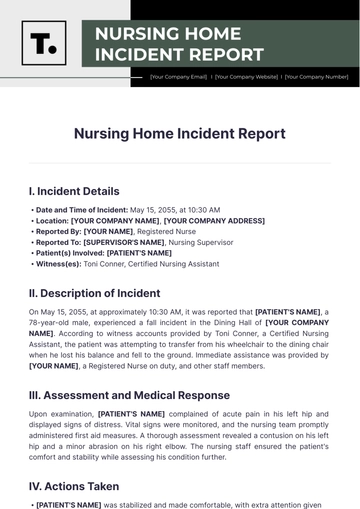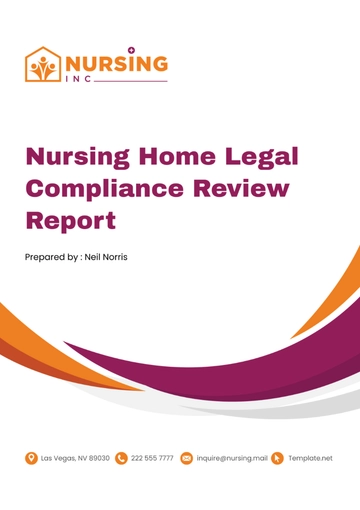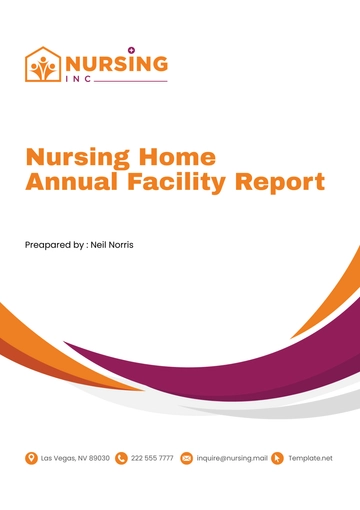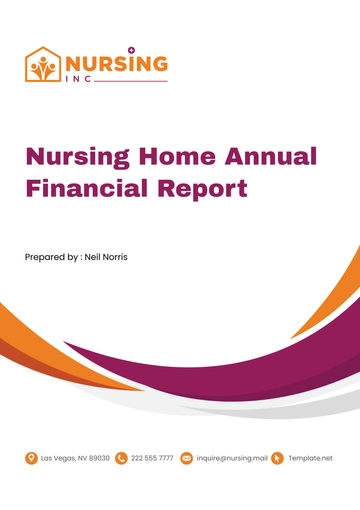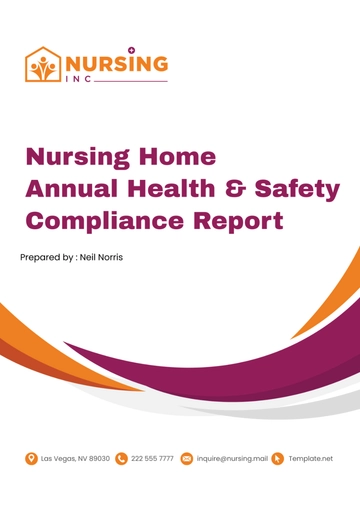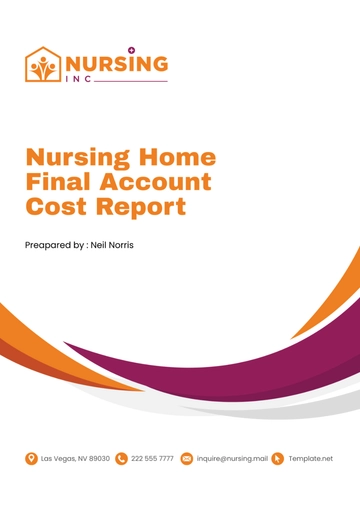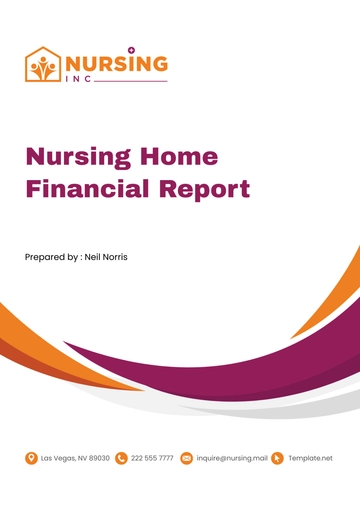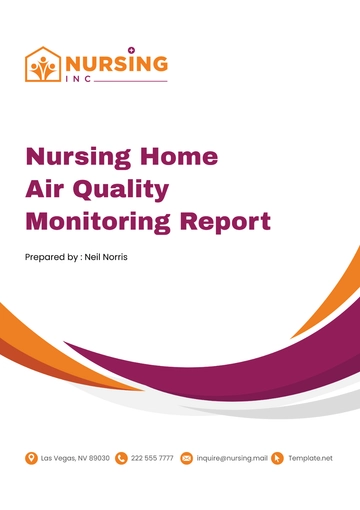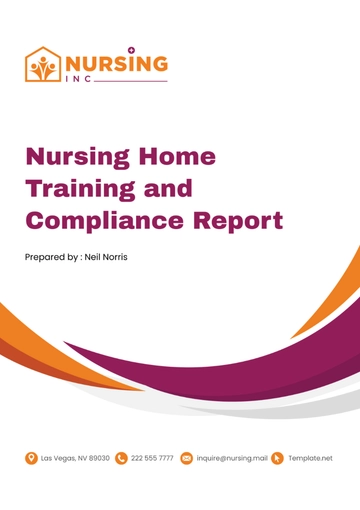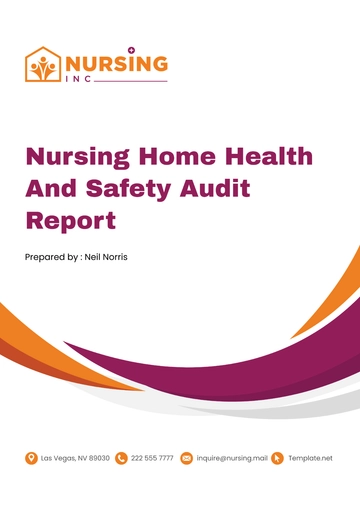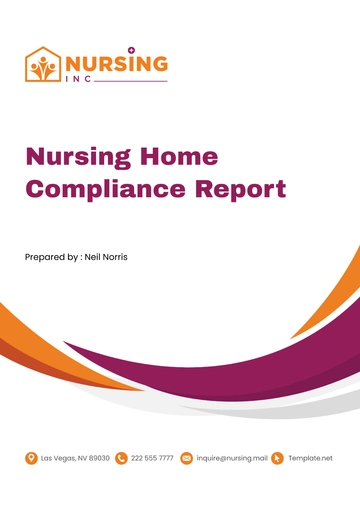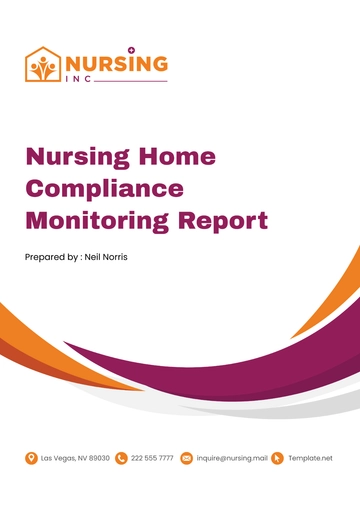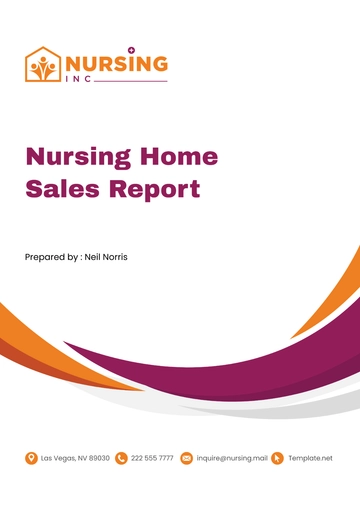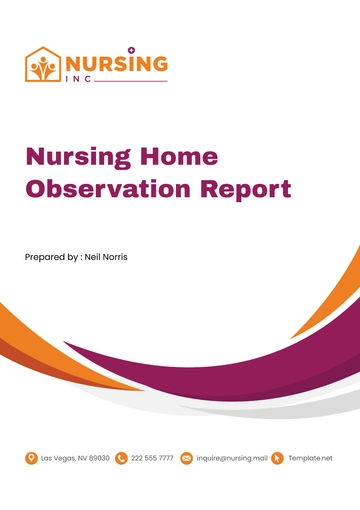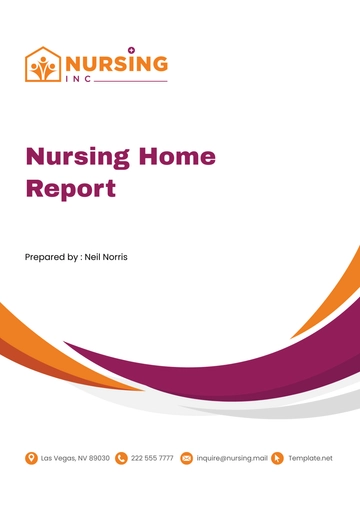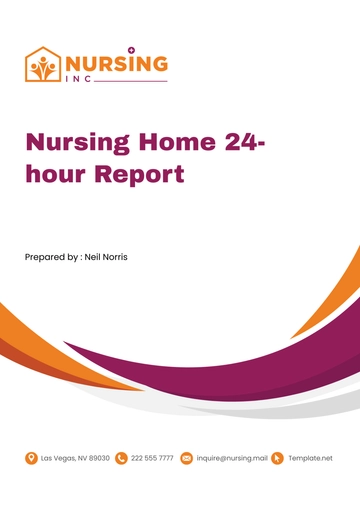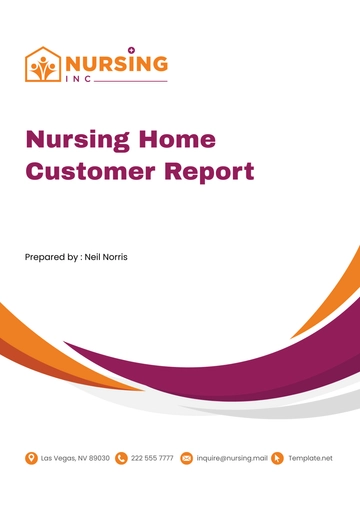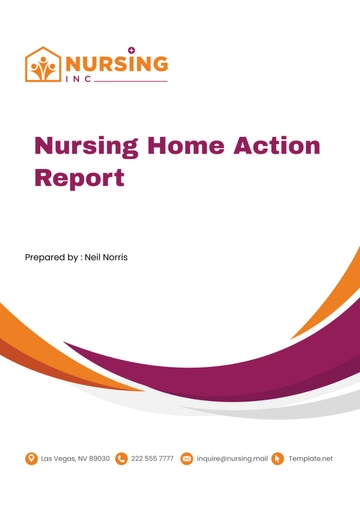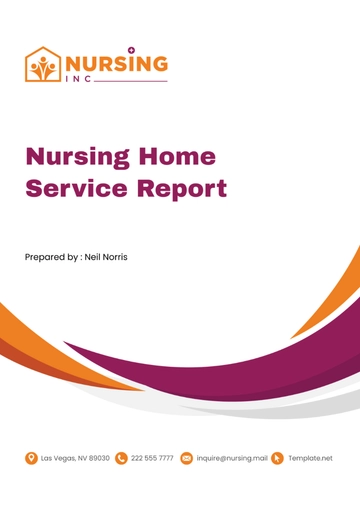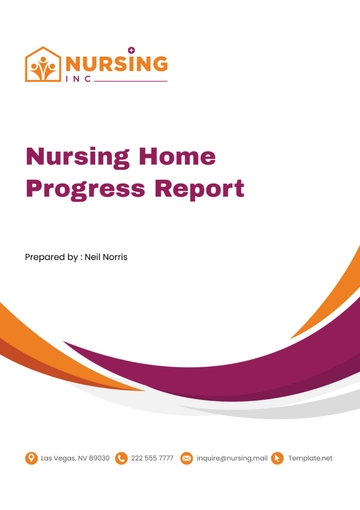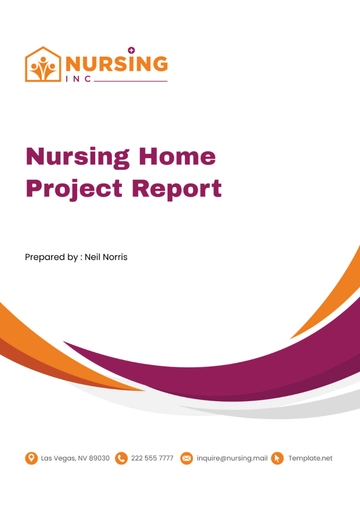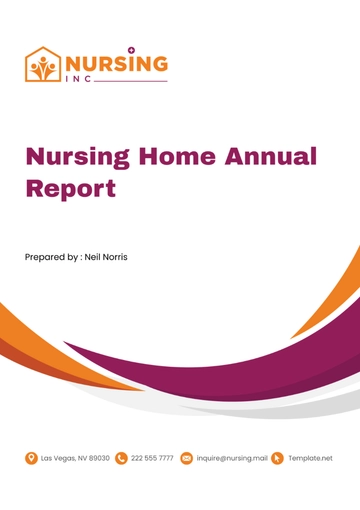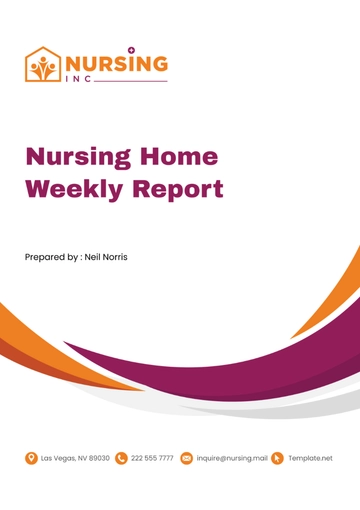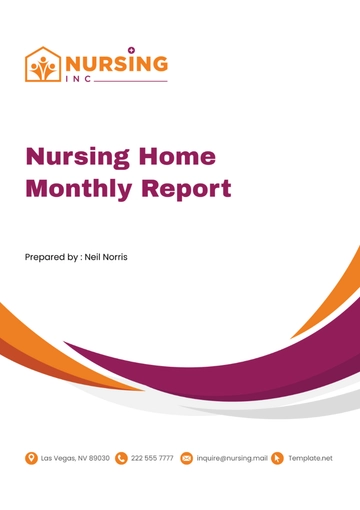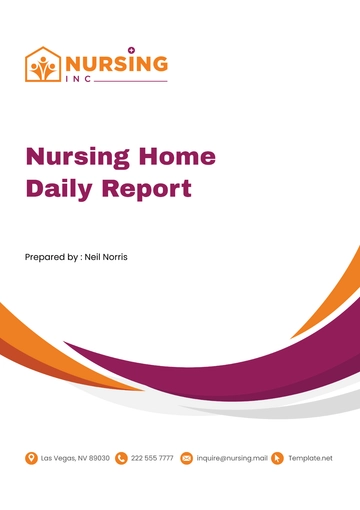Free Nursing Home Staffing Report
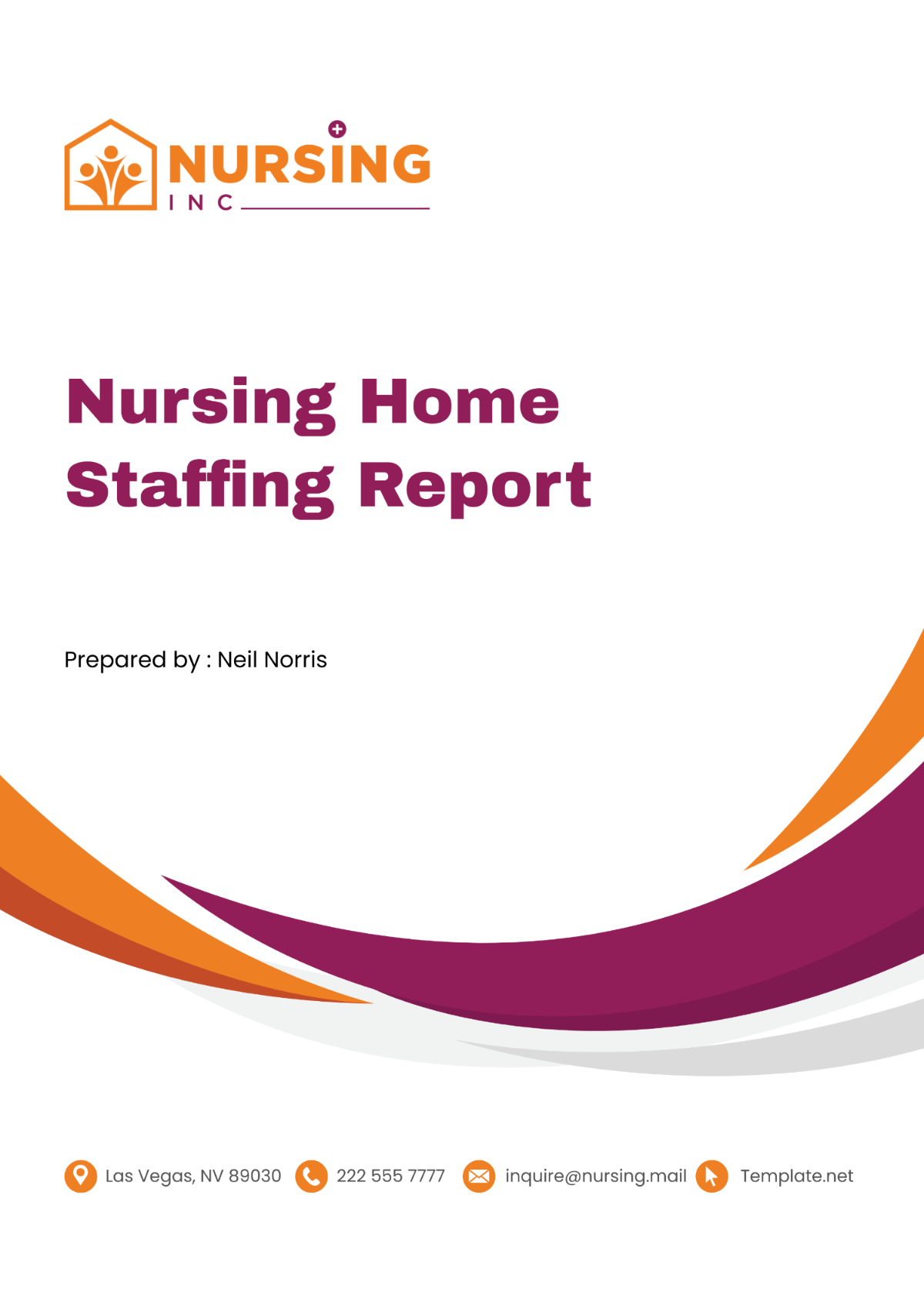
I. Executive Summary
This report provides a comprehensive analysis of the current staffing situation within our nursing home, focusing on staff levels, composition, and their impact on the quality of care provided to our residents. Through detailed examination and comparison with industry benchmarks and regulatory standards, we aim to identify areas for improvement and develop strategies to enhance both staff and resident satisfaction while ensuring compliance with all relevant guidelines. Our findings reveal several key areas that require attention to optimize staffing effectiveness and improve the overall care environment.
Staff-to-resident ratio falls below the recommended standard of 1:5 for daytime and 1:10 for nighttime, impacting the quality of care.
High turnover rates among Certified Nursing Assistants (CNAs), with an annual turnover rate of 75%.
Utilization of overtime is significantly high, indicating potential understaffing issues, with 40% of RNs and 35% of CNAs working overtime regularly.
Staff satisfaction surveys indicate low satisfaction levels, primarily due to staffing shortages and workload, with only 60% of staff expressing satisfaction with their current working conditions.
Resident satisfaction scores are below the national average, with particular concerns noted regarding responsiveness to care needs.
II. Introduction
The purpose of this staffing report is to assess our current staffing levels, patterns, and practices against established regulatory standards and industry benchmarks. Adequate staffing is critical to ensuring high-quality care and meeting the complex needs of our residents. This assessment serves as a foundational step towards implementing necessary changes to improve our staffing effectiveness and, ultimately, the quality of care we provide.
The Centers for Medicare & Medicaid Services (CMS) recommends a minimum staff-to-resident ratio of 1:5 during daytime hours and 1:10 during nighttime hours for nursing homes.
A minimum of one Registered Nurse (RN) must be on duty 24 hours a day.
At least 75% of all nursing staff hours must be provided by Certified Nursing Assistants (CNAs), Licensed Practical Nurses (LPNs), or Licensed Vocational Nurses (LVNs).
Compliance with these staffing ratios is essential not only for maintaining licensure and funding eligibility but also for ensuring the well-being and satisfaction of our residents.
III. Staffing Overview
A. Current Ratios
Our nursing home's commitment to providing high-quality care is reflected in our efforts to maintain optimal staffing levels. However, a comparison of our current staff-to-resident ratios with regulatory requirements reveals areas for improvement to meet these standards and better address the needs of our residents.
Staff Category | Current Ratio | Regulatory Requirement |
|---|---|---|
Daytime | 1:7 | 1:5 |
Nighttime | 1:12 | 1:10 |
RNs 24/7 | 1 RN | 1 RN |
B. Staff Composition
Our staffing model is designed to ensure a comprehensive care team that meets all aspects of our residents' needs. The following table outlines our current staff composition and the identified needs to optimize care delivery.
Staff | Current Quantity | Identified Needs |
|---|---|---|
Registered Nurses (RNs) | 10 | 15 |
Licensed Practical Nurses (LPNs) | 15 | 20 |
Certified Nursing Assistants (CNAs) | 30 | 45 |
Administrative Staff | 5 | 5 |
IV. Staffing Analysis
A. Current Staffing Patterns and Schedules
Our analysis of current staffing patterns and schedules indicates that while we strive to cover all shifts adequately, there are challenges in meeting the ideal staff-to-resident ratio, especially during peak hours and nighttime. The reliance on a fixed schedule without considering fluctuating resident needs has led to instances where staffing is either insufficient or exceeds requirements, impacting both resident care and staff workload.
B. Review of Overtime and Part-Time Staff Usage
The use of overtime and part-time staff is a critical component of our staffing strategy, allowing us flexibility in managing varying care demands. However, our current reliance on these measures points to underlying staffing challenges.
Staff Category | Percentage of Staff Working Overtime | Average Overtime Hours per Week |
|---|---|---|
RNs | 40% | 8 |
CNAs | 35% | 10 |
The high percentage of RNs and CNAs working overtime frequently reflects an underlying issue of insufficient staffing levels, leading to increased costs and potential burnout among our staff. This situation underscores the need to reevaluate our staffing model and explore strategies to better align our workforce with care demands while minimizing dependency on overtime.
C. Staff Turnover Rates
Staff turnover is a significant concern within our facility, affecting continuity of care and imposing additional costs related to recruitment and training.
Staff Category | Annual Turnover Rate |
|---|---|
RNs | 20% |
CNAs | 75% |
The exceptionally high turnover rate among CNAs indicates dissatisfaction and potential issues within the work environment, such as workload and staffing levels. This turnover not only disrupts the consistency of care but also places additional strain on remaining staff and resources. Addressing the root causes of this turnover is essential for stabilizing our workforce and maintaining the quality of care.
V. Resident Care Needs
Understanding and addressing the diverse needs of our residents is pivotal to delivering high-quality care. The following analysis outlines the resident demographics, their corresponding care needs, the staffing requirements to meet these needs, and how our current staffing aligns with these requirements.
Demographic | Care Need | Staffing Requirement | Current Staffing |
|---|---|---|---|
General Care Residents | Basic Daily Activities | 1 CNA per 8 residents | 1 CNA per 10 residents |
Rehabilitation Residents | Physical Therapy Support | 1 LPN per 5 residents | 1 LPN per 7 residents |
Memory Care Residents | Specialized Dementia Care | 1 CNA per 5 residents | 1 CNA per 7 residents |
Long-term Illness Residents | Continuous Nursing Care | 1 RN per 5 residents | 1 RN per 7 residents |
The table reveals discrepancies between the required and current staffing levels across different resident demographics, indicating a shortfall in meeting the specialized care needs. Particularly, the staffing for Memory Care Residents and Long-term Illness Residents does not meet the recommended requirements, potentially impacting the effectiveness of care provided.
VI. Quality of Care Assessment
A. Resident Satisfaction
Resident satisfaction is a direct indicator of the quality of care and services provided. Our analysis aims to understand how staffing levels influence resident satisfaction.
While a majority of residents express satisfaction to some degree, there's a notable portion that remains neutral or dissatisfied, highlighting areas for improvement. The correlation between dissatisfaction levels and areas of staffing shortfall suggests that enhancing staffing levels could positively impact overall resident satisfaction.
B. Incidents and Complaints Related to Staffing
Incidents and complaints are critical feedback mechanisms, providing insight into areas where staffing levels may directly impact care quality.
The frequency of incidents related to delayed responses and insufficient personal care highlights the impact of inadequate staffing on our ability to meet residents' needs promptly and thoroughly. Addressing these staffing issues is essential to reducing incidents and complaints, thereby improving the overall quality of care.
VII. Staff Satisfaction and Retention
A. Staff Survey Results
Staff satisfaction significantly influences both the quality of care provided to residents and the overall workplace atmosphere. We conducted a comprehensive survey to gauge staff satisfaction levels across various dimensions of their work environment.
The survey results reveal areas of concern, particularly regarding perceptions of workload and staffing levels, where only a small portion of staff report satisfaction. These areas directly impact not only staff morale but also the retention rates and the quality of care provided. Addressing these concerns is critical for improving staff satisfaction and, by extension, resident care.
B. Retention Rates and Trends
Retention rates serve as a key indicator of the staff's overall satisfaction and engagement. The following table outlines the staff retention rates over the past five years, highlighting trends and changes over time.
The declining trend in retention rates over the years is a significant concern, pointing towards growing dissatisfaction among staff and potentially impacting the consistency and quality of care. Identifying and addressing the underlying causes of this decline is essential for reversing this trend and fostering a stable, committed workforce.
VIII. Financial Implications
A. Cost Analysis of Current Staffing Levels
The financial implications of our current staffing levels are a key consideration in our operational planning and budgeting. Below is a cost analysis of our staffing over the past year.
The analysis reveals the substantial investment made into staffing, underscoring the importance of optimizing staffing levels to ensure financial sustainability. Efficiently managing these costs without compromising care quality is a delicate balance that requires strategic planning and continuous evaluation.
B. Budget Implications of Adjustments
Adjusting staffing levels to meet both care quality standards and financial constraints is a critical challenge. Below is a projected cost analysis for proposed staffing adjustments.
Adjustment | Projected Annual Cost |
|---|---|
Increase RN Staff | $1,400,000 |
Increase LPN Staff | $1,050,000 |
Increase CNA Staff | $1,800,000 |
Total | $4,250,000 |
The proposed adjustments, while necessary for improving care quality and staff satisfaction, will require careful financial planning to manage the increased costs. Identifying areas for cost savings or reallocating resources will be essential for implementing these adjustments sustainably.
C. Potential Savings
Implementing strategic staffing adjustments can lead to potential savings in the long term, despite the initial increase in costs. Savings can be realized through reduced turnover costs, lower reliance on overtime, and improved efficiency leading to better resident outcomes and potentially higher occupancy rates due to enhanced service reputation. Investing in staff development and retention strategies not only improves the quality of care but can also lead to a more financially sustainable operation by mitigating the costs associated with high turnover and understaffing.
IX. Recommendations
Based on the analysis conducted throughout this report, we propose a set of recommendations aimed at addressing the identified staffing challenges, enhancing the quality of care provided to our residents, and improving staff satisfaction and retention rates. These recommendations are designed to be both impactful and feasible, ensuring our nursing home can continue to deliver exceptional care while maintaining financial sustainability.
Increase Staffing Levels: Adjust staffing ratios to meet or exceed regulatory requirements, particularly for CNAs during nighttime shifts, to ensure adequate resident care.
Implement Flexible Scheduling: Adopt more flexible scheduling models to reduce overtime reliance and improve work-life balance for staff.
Enhance Staff Support and Development: Expand professional development opportunities and support programs for staff, including access to continuing education and mentorship programs.
Improve Staff Retention: Develop targeted retention strategies, such as competitive compensation packages, recognition programs, and career advancement pathways.
Optimize Financial Planning: Reassess the budget to accommodate the proposed staffing adjustments, identifying areas for reallocation or potential savings without compromising care quality.
Regularly Review Staffing and Care Quality: Establish an ongoing review process for staffing levels and care quality, ensuring adjustments are made in response to evolving resident needs and feedback.
Engage Staff in Decision-Making: Involve staff in discussions about workplace improvements and changes, fostering a sense of ownership and engagement.
X. Conclusion
The findings and recommendations outlined in this report underscore the critical role that staffing plays in the delivery of high-quality care within our nursing home. Addressing the identified staffing challenges through strategic adjustments and enhancements is essential for improving both resident outcomes and staff satisfaction. Implementing these recommendations requires commitment and collaboration across all levels of our organization. We are confident that by taking proactive steps to optimize our staffing model, we can continue to provide the exceptional level of care our residents deserve, while also creating a supportive and rewarding environment for our staff.
- 100% Customizable, free editor
- Access 1 Million+ Templates, photo’s & graphics
- Download or share as a template
- Click and replace photos, graphics, text, backgrounds
- Resize, crop, AI write & more
- Access advanced editor
Optimize your workforce with the Nursing Home Staffing Report Template from Template.net. Designed for precision, this editable and customizable template aids in analyzing and enhancing staffing strategies to meet the highest care standards. Ensure your staffing aligns with care needs efficiently, with everything editable in our AI Editor tool, making it indispensable for workforce management.
You may also like
- Sales Report
- Daily Report
- Project Report
- Business Report
- Weekly Report
- Incident Report
- Annual Report
- Report Layout
- Report Design
- Progress Report
- Marketing Report
- Company Report
- Monthly Report
- Audit Report
- Status Report
- School Report
- Reports Hr
- Management Report
- Project Status Report
- Handover Report
- Health And Safety Report
- Restaurant Report
- Construction Report
- Research Report
- Evaluation Report
- Investigation Report
- Employee Report
- Advertising Report
- Weekly Status Report
- Project Management Report
- Finance Report
- Service Report
- Technical Report
- Meeting Report
- Quarterly Report
- Inspection Report
- Medical Report
- Test Report
- Summary Report
- Inventory Report
- Valuation Report
- Operations Report
- Payroll Report
- Training Report
- Job Report
- Case Report
- Performance Report
- Board Report
- Internal Audit Report
- Student Report
- Monthly Management Report
- Small Business Report
- Accident Report
- Call Center Report
- Activity Report
- IT and Software Report
- Internship Report
- Visit Report
- Product Report
- Book Report
- Property Report
- Recruitment Report
- University Report
- Event Report
- SEO Report
- Conference Report
- Narrative Report
- Nursing Home Report
- Preschool Report
- Call Report
- Customer Report
- Employee Incident Report
- Accomplishment Report
- Social Media Report
- Work From Home Report
- Security Report
- Damage Report
- Quality Report
- Internal Report
- Nurse Report
- Real Estate Report
- Hotel Report
- Equipment Report
- Credit Report
- Field Report
- Non Profit Report
- Maintenance Report
- News Report
- Survey Report
- Executive Report
- Law Firm Report
- Advertising Agency Report
- Interior Design Report
- Travel Agency Report
- Stock Report
- Salon Report
- Bug Report
- Workplace Report
- Action Report
- Investor Report
- Cleaning Services Report
- Consulting Report
- Freelancer Report
- Site Visit Report
- Trip Report
- Classroom Observation Report
- Vehicle Report
- Final Report
- Software Report
